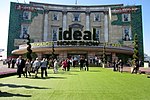Earl's Court
Earl's Court is a district of Kensington in the Royal Borough of Kensington and Chelsea in West London, bordering the rail tracks of the West London line and District line that separate it from the ancient borough of Fulham to the west, the sub-districts of South Kensington to the east, Chelsea to the south and Kensington to the northeast. It lent its name to the now defunct eponymous pleasure grounds opened in 1887 followed by the pre–World War II Earls Court Exhibition Centre, as one of the country's largest indoor arenas and a popular concert venue, until its closure in 2014. The area has long been known as "Bedsitter Land" with many of its stuccoed terraces converted into studio flats, hotels and hostels.In practice, the notion of Earl's Court, which is geographically confined to the SW5 postal district, tends to apply beyond its boundary to parts of the neighbouring Fulham area with its SW6 and W14 postcodes to the west, and to adjacent streets in postcodes SW7, SW10 and W8 in Kensington and Chelsea. Earl's Court is also an electoral ward of the local authority, Kensington and Chelsea London Borough Council. Its population at the 2011 census was 9,104.
Excerpt from the Wikipedia article Earl's Court (License: CC BY-SA 3.0, Authors).Earl's Court
Trebovir Road, London Earl's Court (Royal Borough of Kensington and Chelsea)
Geographical coordinates (GPS) Address Nearby Places Show on map
Geographical coordinates (GPS)
| Latitude | Longitude |
|---|---|
| N 51.490616 ° | E -0.195848 ° |
Address
Kensington Mansions
Trebovir Road
SW5 9TD London, Earl's Court (Royal Borough of Kensington and Chelsea)
England, United Kingdom
Open on Google Maps










